Asteroids and comets. The solar system includes...
Asteroids. Meteorites. Meteors.
Asteroid
ASTEROID - a small planet-like celestial body solar system, moving in orbit around the Sun. Asteroids, also known as minor planets, are significantly smaller in size than planets.
Definitions.
The term asteroid (from ancient Greek - “like a star”) was introduced by William Herschel on the basis that these objects, when observed through a telescope, looked like points of stars - in contrast to planets, which when observed through a telescope, looked like disks. The exact definition of the term "asteroid" is still not established. The term “minor planet” (or “planetoid”) is not suitable for defining asteroids, since it also indicates the location of the object in the Solar System. However, not all asteroids are minor planets.
One way to classify asteroids is by size. The current classification defines asteroids as objects with a diameter greater than 50 m, separating them from meteoroids, which look like large rocks or may be even smaller. The classification is based on the assertion that asteroids can survive entry into the Earth's atmosphere and reach its surface, while meteors, as a rule, burn up completely in the atmosphere.
As a result, an “asteroid” can be defined as a solar system object made of solid materials that is larger than a meteor.
Asteroids in the Solar System
To date, tens of thousands of asteroids have been discovered in the Solar System. As of September 26, 2006, there were 385,083 objects in the databases, 164,612 had precisely defined orbits and were assigned an official number. 14,077 of them at this time had officially approved names. It is estimated that the Solar System may contain from 1.1 to 1.9 million objects larger than 1 km. Most currently known asteroids are concentrated within the asteroid belt, located between the orbits of Mars and Jupiter.
The most large asteroid In the solar system, Ceres was considered to have dimensions of approximately 975 × 909 km, but since August 24, 2006, it received the status of a dwarf planet. The other two largest asteroids, 2 Pallas and 4 Vesta, have a diameter of ~500 km. 4 Vesta is the only object in the asteroid belt that can be observed with the naked eye. Asteroids moving in other orbits can also be observed during their passage near the Earth (for example, 99942 Apophis).
The total mass of all main belt asteroids is estimated at 3.0-3.6×1021 kg, which is only about 4% of the mass of the Moon. The mass of Ceres is 0.95 × 1021 kg, that is, about 32% of the total, and together with the three largest asteroids 4 Vesta (9%), 2 Pallas (7%), 10 Hygea (3%) - 51%, that is, the absolute majority asteroids have negligible mass.
Asteroid exploration
The study of asteroids began after the discovery of the planet Uranus in 1781 by William Herschel. Its average heliocentric distance turned out to correspond to the Titius-Bode rule.
At the end of the 18th century, Franz Xaver von Zach organized a group that included 24 astronomers. Since 1789, this group has been searching for a planet that, according to the Titius-Bode rule, should be located at a distance of about 2.8 astronomical units from the Sun - between the orbits of Mars and Jupiter. The task was to describe the coordinates of all stars in the area of zodiacal constellations at a certain moment. On subsequent nights, the coordinates were checked and objects that had moved greater distances were identified. The estimated displacement of the desired planet should have been about 30 arcseconds per hour, which should have been easy to notice.
Ironically, the first asteroid, 1 Ceres, was discovered by accident by the Italian Piazzi, who was not involved in this project, in 1801, on the first night of the century. Three others - 2 Pallas, 3 Juno and 4 Vesta - were discovered over the next few years - the last, Vesta, in 1807. After another 8 years of fruitless searching, most astronomers decided that there was nothing more there and stopped research.
However, Karl Ludwig Henke persisted, and in 1830 he resumed the search for new asteroids. Five years later, he discovered Astraea, the first new asteroid in 38 years. He also discovered Hebe less than two years later. After this, other astronomers joined the search, and then at least one new asteroid was discovered per year (with the exception of 1945).
In 1891, Max Wolf was the first to use the astrophotography method to search for asteroids, in which asteroids left short light lines in photographs with a long exposure period. This method significantly increased the number of detections compared to previously used visual observation methods: Wolff single-handedly discovered 248 asteroids, starting with 323 Brutius, while little more than 300 had been discovered before him. Now, a century later, only a few thousand asteroids have been identified, numbered and named. Much is known about them more, however, scientists are not very worried about studying them, calling asteroids “vermin of the skies”.
Asteroid naming
At first, asteroids were given the names of heroes of the Roman and Greek mythology, later the discoverers gained the right to call it whatever they wanted, for example, by their own name. At first, asteroids were given predominantly female names; only asteroids with unusual orbits (for example, Icarus, approaching the Sun closer than Mercury) received male names. Later, this rule was no longer observed.
Not any asteroid can receive a name, but only one whose orbit has been more or less reliably calculated. There have been cases when an asteroid received a name decades after its discovery. Until the orbit is calculated, the asteroid is given a serial number reflecting the date of its discovery, for example, 1950 DA. The numbers indicate the year, the first letter is the number of the crescent in the year in which the asteroid was discovered (in the example given, this is the second half of February). The second letter indicates the serial number of the asteroid in the specified crescent; in our example, the asteroid was discovered first. Since there are 24 crescents and 26 English letters, two letters are not used in the designation: I (due to the similarity with the unit) and Z. If the number of asteroids discovered during the crescent exceeds 24, they again return to the beginning of the alphabet, assigning the second the letter index is 2, the next time it returns - 3, etc.
After receiving a name, the official naming of the asteroid consists of a number (serial number) and a name - 1 Ceres, 8 Flora, etc.
Asteroid belt
The orbits of the majority of numbered minor planets (98%) are located between the orbits of the planets Mars and Jupiter. Their average distances from the Sun range from 2.2 to 3.6 AU. They form the so-called main asteroid belt. All small planets, like large ones, move in a forward direction. The periods of their revolution around the Sun range from three to nine years, depending on the distance. It is easy to calculate that the linear speed is approximately 20 km/s. The orbits of many small planets are noticeably elongated. Eccentricities rarely exceed 0.4, but, for example, for asteroid 2212 Hephaestus it is 0.8. Most orbits are located close to the ecliptic plane, i.e. to the plane of the Earth's orbit. Tilts are usually a few degrees, but there are exceptions. Thus, the orbit of Ceres has an inclination of 35°, and large inclinations are also known.
Perhaps, for us inhabitants of the Earth, it is most important to know the asteroids whose orbits are close to the orbit of our planet. There are usually three families of near-Earth asteroids. They are named after typical representatives - minor planets: 1221 Amur, 1862 Apollo, 2962 Aten. The Amur family includes asteroids whose orbits at perihelion almost touch the orbit of the Earth. The Apollo missions cross the Earth's orbit from the outside, their perhelion distance is less than 1 AU. "Atonans" have orbits with a semi-major axis smaller than the Earth's and intersect the Earth's orbit from the inside. Representatives of all these families can meet with the Earth. As for close passes, they happen quite often.
For example, the asteroid Amur at the time of discovery was 16.5 million kilometers from the Earth, 2101 Adonis approached by 1.5 million kilometers, 2340 Hathor - by 1.2 million kilometers. Astronomers at many observatories observed the passage of asteroid 4179 Tautatis past Earth. On December 8, 1992, he was 3.6 million kilometers away from us.
The majority of asteroids are concentrated in the main belt, but there are important exceptions. Long before the discovery of the first asteroid, the French mathematician Joseph Louis Lagrange studied the so-called three-body problem, i.e. investigated how three bodies move under the influence of gravity. The problem is very complex and in general terms has not yet been solved. However, Lagrange managed to find that in the system of three gravitating bodies (Sun - planet - small body) there are five points where the movement of the small body turns out to be stable. Two of these points are in the orbit of the planet, forming equilateral triangles with it and the Sun.
Many years later, already in the 20th century, theoretical constructions became reality. Near the Lagrangian points in the orbit of Jupiter, about two dozen asteroids were discovered, which were given the names of the heroes of the Trojan War. The “Greeks” asteroids (Achilles, Ajax, Odysseus, etc.) are 60° ahead of Jupiter, the “Trojans” follow at the same distance behind. It is estimated that the number of asteroids near Lagrange points can reach several hundred.
Dimensions and material composition
To find out the size of any astronomical object (if the distance to it is known), it is necessary to measure the angle at which it is visible from the Earth. However, it is no coincidence that asteroids are called minor planets. Even with large telescopes under excellent atmospheric conditions, using very complex, labor-intensive techniques, it is possible to obtain rather vague outlines of the disks of only a few of the largest asteroids. The photometric method turned out to be much more effective. There are very accurate instruments that measure gloss, i.e. stellar magnitude of the celestial body. In addition, the illumination created by the Sun on an asteroid is well known. All other things being equal, the brightness of an asteroid is determined by the area of its disk. It is, however, necessary to know what fraction of the light a given surface reflects. This reflectivity is called albedo. Methods have been developed for its determination by the polarization of asteroid light, as well as by the difference in brightness in the visible region of the spectrum and in the infrared range. As a result of measurements and calculations, the following sizes of the largest asteroids were obtained.
It is believed that there are three dozen asteroids with diameters of more than 200 km. Almost all of them are probably known. There are probably about 800 small planets with diameters from 80 to 200 km. With decreasing size, the number of asteroids increases rapidly. Photometric studies have shown that asteroids vary greatly in the degree of blackness of the material composing their surface. 52 Europe in particular has an albedo of 0.03. This corresponds to a dark substance similar in color to soot. Such dark asteroids are conventionally called carbonaceous (class C). Asteroids of another class are conventionally called stony (S), since they apparently resemble the deep rocks of the Earth. The albedo of S-asteroids is much higher. For example, at 44 Niza it reaches 0.38. This is the lightest asteroid. The study of reflection spectra and polarimetry made it possible to identify another class - metallic, or M-asteroids. Probably, on their surface there are outcrops of metal, for example nickel iron, like some meteorites.
Using very sensitive photometers, periodic changes in the brightness of asteroids were studied. The shape of the light curve can be used to judge the rotation period of the asteroid and the position of the rotation axis. The periods are very different - from several hours to hundreds of hours. Studying the light curve also allows us to draw certain conclusions about the shape of asteroids. Most of them have an irregular, clastic shape. Only the largest ones approach the ball.
The pattern of changes in the brightness of some asteroids suggests that they have satellites. Some of the minor planets may be close binary systems or even bodies rolling on each other's surfaces.
But reliable information about asteroids can only be obtained from close-range observations - from spacecraft. We already have such experience. On October 29, 1991, the American Galileo spacecraft transmitted an image of asteroid 951 Gaspra to Earth. The picture was taken from a distance of 16 thousand kilometers. It clearly shows the angular-smoothed shape of the asteroid and its cratered surface. We can confidently determine the dimensions: 12x16 km.
For a long time, no asteroids were known whose orbits lay entirely outside the orbit of Jupiter. But in 1977, such a small planet was discovered - this is 2060 Chiron. Observations have shown that its perihelion (the point of its orbit closest to the Sun) lies inside the orbit of Saturn, and its aphelion (the point of greatest removal) - almost at the very orbit of Uranus, on the distant, cold and dark outskirts of the planetary system. The distance to Chiron at perihelion is 8.51 AU, and at aphelion - 18.9 AU. More distant asteroids have also been discovered. It is assumed that they form a second, outer asteroid belt (Kuiper belt).
The brightest asteroid
The asteroid that appears the brightest from Earth is Vesta(4). When Vesta is at its closest possible distance from Earth, its brightness reaches magnitude 6.5. In very dark skies, Vesta can even be seen with the naked eye (it is the only asteroid that can be seen with the naked eye at all). The next brightest asteroid is Ceres, but its brightness never exceeds magnitude 7.3. Although Vesta is three-fifths the size of Ceres, it is much more reflective. Vesta reflects about 25% of the sunlight falling on it, while Ceres reflects only 5%. Vesta appears to be a light-colored volcanic rock that is highly reflective. Asteroids with this reflectivity belong to a separate class known as type E (the class designation comes from the name of the mineral enstatite). Such asteroids are rare, and their reflectivity ranges from 30 to 40%. The brightest of them, Nisa (44), has a magnitude of 9.7, although its diameter is only 68 km.
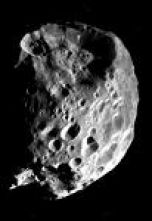
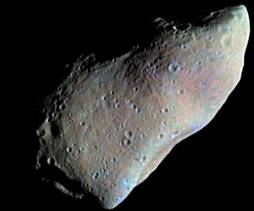
METEORITE
METEORITE - a piece of extraterrestrial matter that fell to the surface of the Earth; Literally, “stone from the sky.”
Meteorites are the oldest known minerals (4.5 billion years old), so they should preserve traces of the processes that accompanied the formation of the planets. Until samples of lunar soil were brought to Earth, meteorites remained the only samples of extraterrestrial matter. Geologists, chemists, physicists and metallurgists have been collecting and studying meteorites for more than 200 years. From these studies the science of meteorites emerged. Although the first reports of meteorite falls appeared a long time ago, scientists were very skeptical about them. Various facts led them to finally believe in the existence of meteorites. In 1800–1803 several famous European chemists reported that chemical composition"meteor rocks" from different places fall is similar, but different from the composition of earthly rocks. Finally, when in 1803 a terrible “rain of stones” broke out in Aigle (France), littering the ground with fragments and witnessed by many excited eyewitnesses, the French Academy of Sciences was forced to agree that these were indeed “stones from the sky.” It is now believed that meteorites are fragments of asteroids and comets.
Meteorites are divided into “fallen” and “found”. If a person saw a meteorite fall through the atmosphere and then actually found it on the ground (a rare event), then such a meteorite is called a "fallen". If it was found by chance and identified, which is typical for iron meteorites, then it is called “found.” Meteorites are named after the places where they were found. In some cases, not one, but several fragments are found. For example, after the 1912 meteor shower in Holbrook (Arizona), more than 20 thousand fragments were collected.
Meteorite fall. Until a meteorite reaches the Earth, it is called a meteoroid. Meteoroids fly into the atmosphere at speeds from 11 to 30 km/s. At an altitude of about 100 km, due to friction with the air, the meteoroid begins to heat up; its surface becomes hot, and a layer several millimeters thick melts and evaporates. At this time it is visible as a bright meteor (see METEOR). The molten and evaporated substance is continuously carried away by air pressure - this is called ablation. Sometimes, under the pressure of air, a meteor is crushed into many fragments. Passing through the atmosphere, it loses from 10 to 90% of its initial mass. However, the interior of the meteor usually remains cold, since it does not have time to warm up during the 10 seconds that the fall lasts. Overcoming air resistance, small meteorites significantly reduce their flight speed by the time they hit the ground and usually go deeper into the ground by no more than a meter, and sometimes they simply remain on the surface. Large meteorites are slowed down only slightly and upon impact produce an explosion with the formation of a crater, such as in Arizona or on the Moon. The largest meteorite found is the iron meteorite Goba (South Africa), whose weight is estimated at 60 tons. It was never moved from the place where it was found.
Every year, several meteorites are picked up immediately after their observed fall. In addition, more and more old meteorites are being discovered. In two places in the east of the state. In New Mexico, where the wind constantly blows away the soil, 90 meteorites were found. Hundreds of meteorites have been discovered on the surface of evaporating glaciers in Antarctica. Recently fallen meteorites are covered with a vitrified, sintered crust that is darker than the interior. Meteorites are of great scientific interest; Most major natural science museums and many universities have meteorite experts.
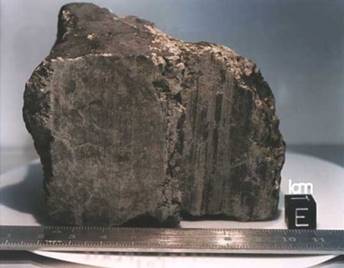 METEORITE, possibly coming from Mars. Discovered in Antarctica in 1984.
METEORITE, possibly coming from Mars. Discovered in Antarctica in 1984. Types of meteorites. There are meteorites made of various substances. Some are primarily composed of an iron-nickel alloy containing up to 40% nickel. Among fallen meteorites only 5.7% are iron, but in collections their share is much larger, since they deteriorate more slowly under the influence of water and wind, and they are also easier to detect by appearance. If you polish a section of an iron meteorite and lightly etch it with acid, you can often see a crystalline pattern of intersecting stripes formed by alloys with different nickel contents. This drawing is called “Widmanstätten figures” in honor of A. Widmanstätten (1754–1849), who was the first to observe them in 1808.

The IRON METEORITE from Henbury (Australia) is a typical metallic type meteorite, many of which are rich in compounds found in iron ores.
Stony meteorites are divided into two large groups: chondrites and achondrites. Chondrites are the most common, accounting for 84.8% of all fallen meteorites. They contain rounded millimeter-sized grains - chondrules; Some meteorites are composed almost entirely of chondrules. Chondrules have not been found in terrestrial rocks, but glassy grains of similar size have been found in lunar soil. Chemists have studied them carefully because the chemical composition of chondrules likely represents the primordial matter of the solar system. This standard composition is called the “cosmic abundance of elements.” In chondrites of a certain type, containing up to 3% carbon and 20% water, signs of biological matter were intensively searched, but no signs of living organisms were found in either these or other meteorites. Achondrites lack chondrules and resemble lunar rock in appearance.
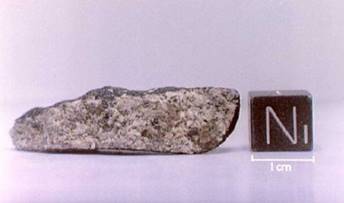
METEORITE-ACHONDRITE
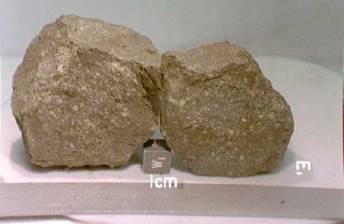
METEORITE-CHONDRITE
Parent bodies of meteorites. The study of the mineralogical, chemical and isotopic composition of meteorites has shown that they are fragments of larger objects in the Solar System. The maximum radius of these parent bodies is estimated at 200 km. The largest asteroids are approximately this size. The estimate is based on the cooling rate of the iron meteorite, at which two alloys with nickel are obtained, forming Widmanstätten figures. Stone meteorites were probably knocked from the surface not major planets, devoid of atmosphere and covered with craters, like the Moon. Cosmic radiation destroyed the surface of these meteorites in the same way as moon rocks. However, the chemical composition of meteorites and lunar samples is so different that it is quite obvious that the meteorites did not come from the Moon. Scientists were able to photograph two meteorites as they fell and calculate their orbits from the photographs: it turned out that these bodies came from the asteroid belt. Asteroids are likely the main sources of meteorites, although some may be particles from evaporated comets.
METEOR. The word "meteor" in Greek was used to describe various atmospheric phenomena, but now it refers to phenomena that occur when particulate matter from space enters the upper atmosphere. In the narrow sense, a “meteor” is a luminous streak along the path of a decaying particle. However, in everyday life this word often refers to the particle itself, although scientifically it is called a meteoroid. If part of a meteoroid reaches the surface, it is called a meteorite. Meteors are popularly called “shooting stars.” Very bright meteors are called fireballs; Sometimes this term refers only to meteor events accompanied by sound phenomena.
Frequency of occurrence. The number of meteors that an observer can see in a given period of time is not constant. In good conditions, away from city lights and in the absence of bright moonlight, an observer may notice 5–10 meteors per hour. Most meteors glow for about a second and appear fainter than the brightest stars. After midnight, meteors appear more often, since the observer at this time is located on the forward side of the Earth along the orbital movement, which receives more particles. Each observer can see meteors within a radius of about 500 km around themselves. In total, hundreds of millions of meteors appear in the Earth’s atmosphere every day. The total mass of particles entering the atmosphere is estimated at thousands of tons per day - an insignificant amount compared to the mass of the Earth itself. Measurements from spacecraft show that about 100 tons of dust particles, too small to cause the appearance of visible meteors, also hit the Earth per day.
Meteor observation. Visual observations provide a lot of statistical data about meteors, but special instruments are needed to accurately determine their brightness, altitude and flight speed. Astronomers have been using cameras to photograph meteor trails for about a century. A rotating shutter in front of the camera lens makes the meteor trail look like a dotted line, which helps accurately determine time intervals. Typically, this shutter is used to make 5 to 60 exposures per second. If two observers, separated by a distance of tens of kilometers, simultaneously photograph the same meteor, then it is possible to accurately determine the particle's flight altitude, the length of its trail and, based on time intervals, the flight speed.
Since the 1940s, astronomers have observed meteors using radar. The cosmic particles themselves are too small to be detected, but as they fly through the atmosphere they leave a plasma trail that reflects radio waves. Unlike photography, radar is effective not only at night, but also during the day and in cloudy weather. The radar detects small meteoroids that are inaccessible to the camera. Photographs help determine the flight path more accurately, and radar allows you to accurately measure distance and speed.
Television equipment is also used to observe meteors. Electron-optical converters make it possible to register faint meteors. Cameras with CCD matrices are also used. In 1992, while recording a sports competition on a video camera, the flight of a bright fireball was recorded, ending with the fall of a meteorite.
Speed and altitude. The speed at which meteoroids enter the atmosphere ranges from 11 to 72 km/s. The first value is the speed acquired by the body only due to the gravity of the Earth. (A spacecraft must achieve the same speed in order to escape from the Earth’s gravitational field.) A meteoroid arriving from distant regions of the Solar System, due to attraction to the Sun, acquires a speed of 42 km/s near the Earth’s orbit. The Earth's orbital speed is about 30 km/s. If the meeting occurs head-on, then their relative speed is 72 km/s. Any particle arriving from interstellar space must have an even greater speed. The absence of such fast particles proves that all meteoroids are members of the Solar System.
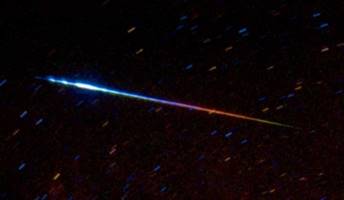 BRIGHT METEOR from the Perseid shower.
BRIGHT METEOR from the Perseid shower. The altitude at which a meteor begins to glow or is detected by radar depends on the particle's entry speed. For fast meteoroids, this height can exceed 110 km, and the particle is completely destroyed at an altitude of about 80 km. In slow-moving meteoroids, this occurs lower down, where the air density is greater. Meteors, comparable in brilliance to the brightest stars, are formed by particles with a mass of tenths of a gram. Larger meteoroids usually take longer to break up and reach lower altitudes. They are significantly slowed down due to friction in the atmosphere. Rare particles fall below 40 km. If a meteoroid reaches altitudes of 10–30 km, then its speed becomes less than 5 km/s and it may fall to the surface as a meteorite.
Orbits. Knowing the meteoroid's speed and the direction from which it approached Earth, an astronomer can calculate its orbit before impact. The Earth and the meteoroid collide when their orbits intersect and they simultaneously find themselves at this intersection point. The orbits of meteoroids can be either almost circular or extremely elliptical, extending beyond planetary orbits.
If a meteoroid approaches the Earth slowly, it means it is moving around the Sun in the same direction as the Earth: counterclockwise, as seen from the north pole of the orbit. Most meteoroid orbits extend beyond the Earth's orbit, and their planes are not very inclined to the ecliptic. The fall of almost all meteorites is associated with meteoroids that had speeds of less than 25 km/s; their orbits lie entirely within the orbit of Jupiter. These objects spend most of their time between the orbits of Jupiter and Mars, in the belt of minor planets - asteroids. Therefore, it is believed that asteroids serve as a source of meteorites. Unfortunately, we can only observe meteoroids that cross the Earth's orbit; Obviously, this group does not fully represent all the small bodies of the Solar System.
Fast meteoroids have more elongated orbits and are more inclined to the ecliptic. If a meteoroid approaches at a speed of more than 42 km/s, then it moves around the Sun in the direction opposite to the direction of the planets. The fact that many comets move in such orbits indicates that these meteoroids are fragments of comets.
Meteor showers. On some days of the year, meteors appear much more often than usual. This phenomenon is called a meteor shower, where tens of thousands of meteors are observed per hour, creating an amazing "star shower" phenomenon across the entire sky. If you trace the paths of meteors in the sky, it will seem that they all fly out from one point, called the radiant of the shower. This phenomenon of perspective, like rails converging at the horizon, indicates that all particles are moving along parallel trajectories.
Astronomers have identified several dozen meteor showers, many of which exhibit annual activity lasting from a few hours to several weeks. Most showers are named after the constellation in which their radiant lies, for example, the Perseids, which have a radiant in the constellation Perseus, and the Geminids, which have a radiant in Gemini.
Meteor showers are observed when the Earth crosses the path of a swarm of particles formed by the destruction of a comet. Approaching the Sun, the comet is heated by its rays and loses matter. Over several centuries, under the influence of gravitational disturbances from the planets, these particles form an elongated swarm along the comet’s orbit. If the Earth crosses this stream, we can observe a shower of stars every year, even if the comet itself is far from Earth at that moment. Because the particles are not evenly distributed along the orbit, the intensity of rain may vary from year to year. The old flows are so expanded that the Earth crosses them for several days. In cross-section, some threads resemble a ribbon rather than a cord.
The ability to observe the flow depends on the direction of arrival of particles to the Earth. If the radiant is located high in the northern sky, then the stream is not visible from the southern hemisphere of the Earth (and vice versa). The shower's meteors can only be seen if the radiant is above the horizon. If the radiant hits the daytime sky, then the meteors are not visible, but they can be detected by radar. Narrow streams under the influence of planets, especially Jupiter, can change their orbits. If they no longer cross the Earth's orbit, they become unobservable.
The December Geminids shower is associated with remnants small planet or the inactive nucleus of an old comet. There are indications that the Earth collides with other groups of meteoroids generated by asteroids, but these streams are very weak.
Fireballs. Meteors that are brighter than the brightest planets are often called fireballs. Sometimes fireballs are observed brighter than the full moon and extremely rarely those that flare brighter than the sun. Fireballs arise from the largest meteoroids. Among them are many fragments of asteroids, which are denser and stronger than fragments of cometary nuclei. But still, most asteroid meteoroids are destroyed in dense layers of the atmosphere. Some of them fall to the surface as meteorites. Due to the high brightness of the flares, fireballs appear much closer than they really are. Therefore, it is necessary to compare observations of fireballs from different places before organizing a search for meteorites. Astronomers estimate that every day around the Earth, about 12 fireballs end in the fall of meteorites of more than a kilogram.
Physical processes. The destruction of a meteoroid in the atmosphere occurs by ablation, i.e. high-temperature detachment of atoms from its surface under the influence of incident air particles. The hot gas trail remaining behind the meteoroid emits light, but not as a result of chemical reactions, but as a result of the recombination of atoms excited by the impacts. In the spectra of meteors, many bright emission lines are visible, among which the lines of iron, sodium, calcium, magnesium and silicon predominate. Atmospheric nitrogen and oxygen lines are also visible. The chemical composition of meteoroids determined from the spectrum is consistent with data on comets and asteroids, as well as on interplanetary dust collected in upper layers atmosphere.
Many meteors, especially fast ones, leave behind a luminous trail that is visible for a second or two, and sometimes for much longer. When large meteorites fell, the trail was observed for several minutes. The glow of oxygen atoms at altitudes of approx. 100 km can be explained by tracks lasting no more than a second. Longer trails arise from the complex interaction of the meteoroid with the atoms and molecules of the atmosphere. Dust particles along the bolide's trajectory can form a bright trail if the upper layers of the atmosphere, where they are scattered, are illuminated by the Sun, when the observer below is in deep twilight.
The speeds of meteoroids are hypersonic. When a meteoroid reaches relatively dense layers of the atmosphere, a powerful shock wave occurs, and strong sounds can be carried tens of kilometers or more. These sounds are reminiscent of thunder or distant cannonade. Due to the great distance, the sound arrives a minute or two after the car appears. For several decades, astronomers have debated the reality of the anomalous sound, which some observers heard directly at the moment the fireball appeared and described it as a crackling or whistling sound. Research has shown that the sound is caused by disturbances in the electric field near the car, under the influence of which objects close to the observer - hair, fur, trees - produce sound.
Meteorite danger. Large meteoroids can destroy spacecraft, and small dust particles constantly wear away their surface. The impact of even a small meteoroid can impart an electrical charge to a satellite, which will disable electronic systems. The risk is generally low, but spacecraft launches are still sometimes postponed if a strong meteor shower is expected.
Bibliography
1 Simonenko A.N. Meteorites are fragments of asteroids. M., 1979
2 Getman V.S. Grandchildren of the Sun. M., 1989
Subject: Asteroids. Comets. Meteors. Meteorites.
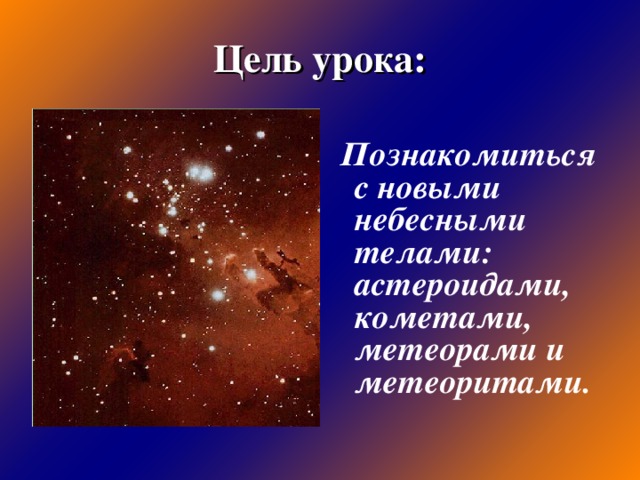
The purpose of the lesson:
Get acquainted with new celestial bodies: asteroids, comets, meteors and meteorites.
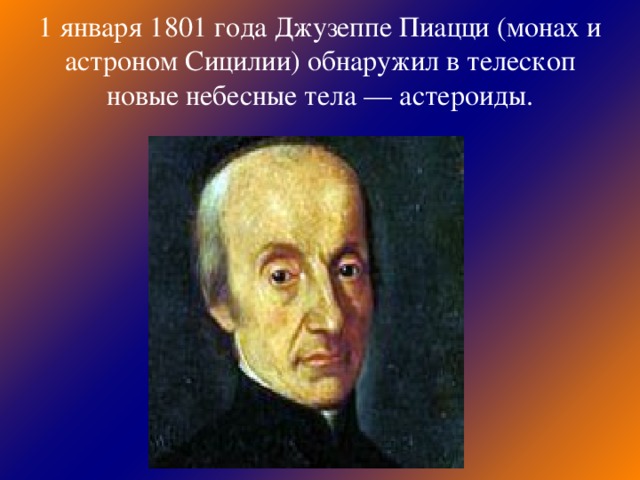
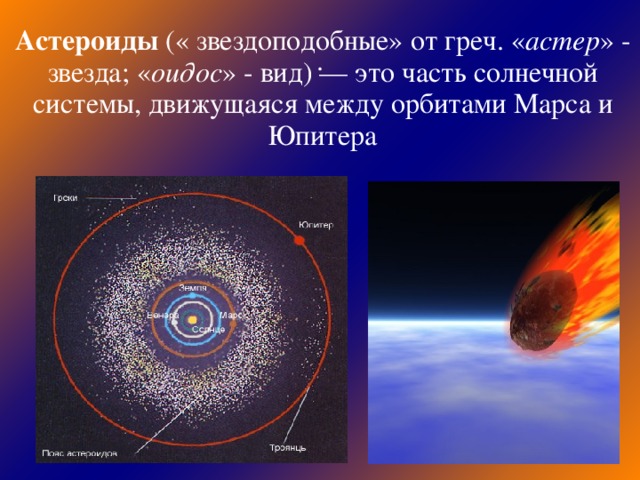
Asteroids("star-like" from Greek. " Aster" - star; " oidos" - view) is a part of the solar system moving between the orbits of Mars and Jupiter
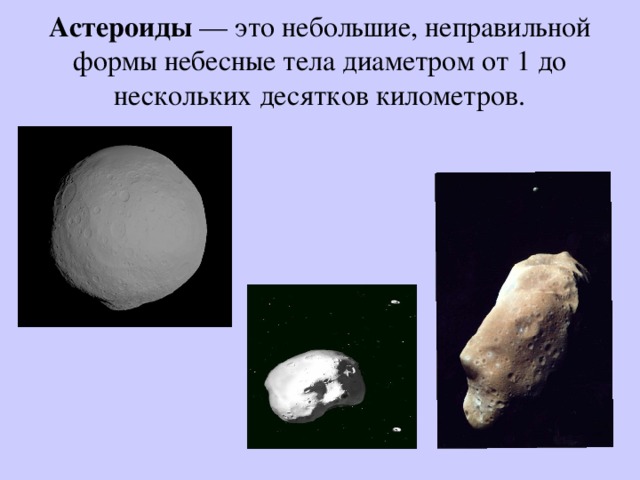
Asteroids- these are small, irregularly shaped celestial bodies with a diameter of 1 to several tens of kilometers.
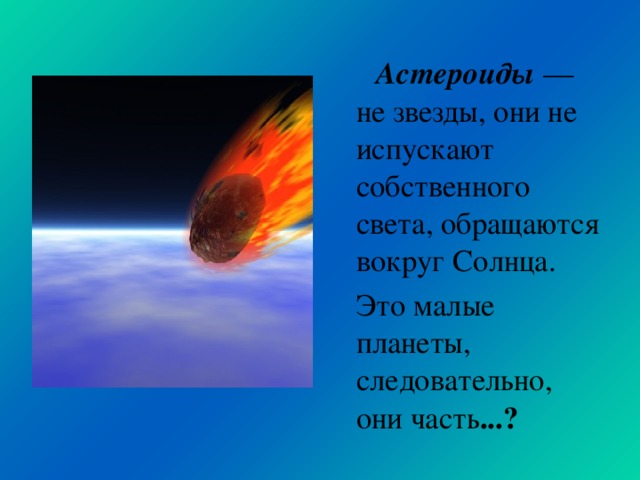
Asteroids - not stars, they do not emit their own light, they revolve around the Sun.
These are minor planets, therefore they are part ...?
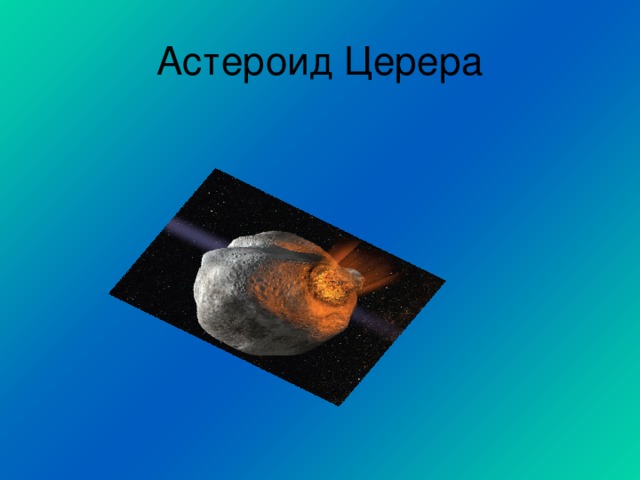
It is the largest and most massive asteroid in the belt between Mars and Jupiter. It has an approximate size of 975 km by 909 km.
- It was named after the ancient Roman goddess of fertility Ceres .
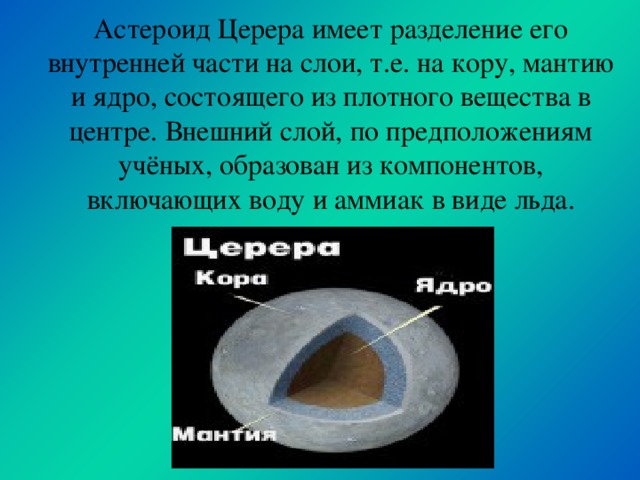
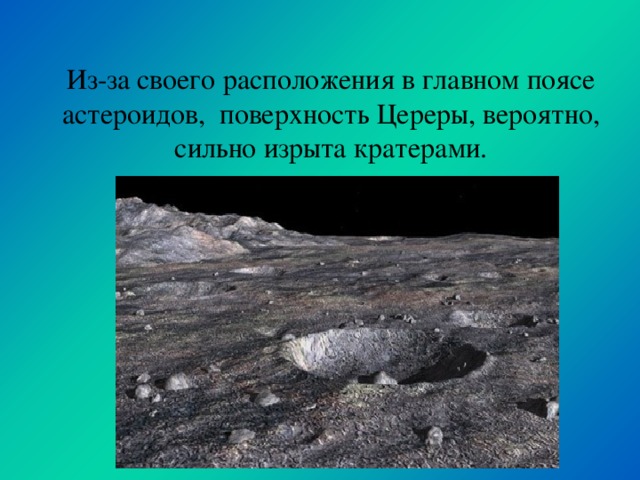
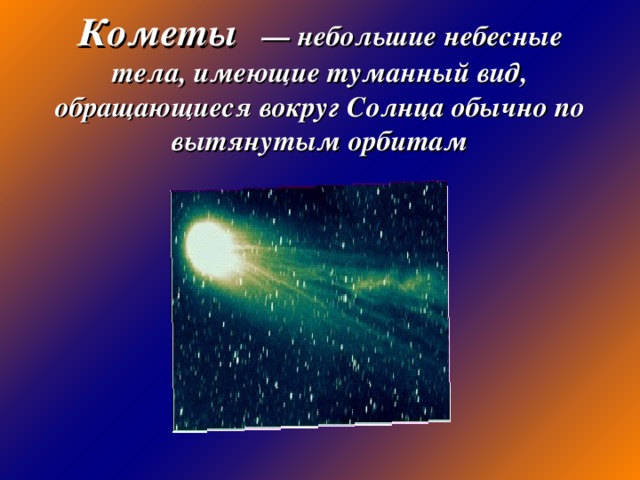
Comets - small celestial bodies that have a nebulous appearance, usually revolving around the Sun in elongated orbits
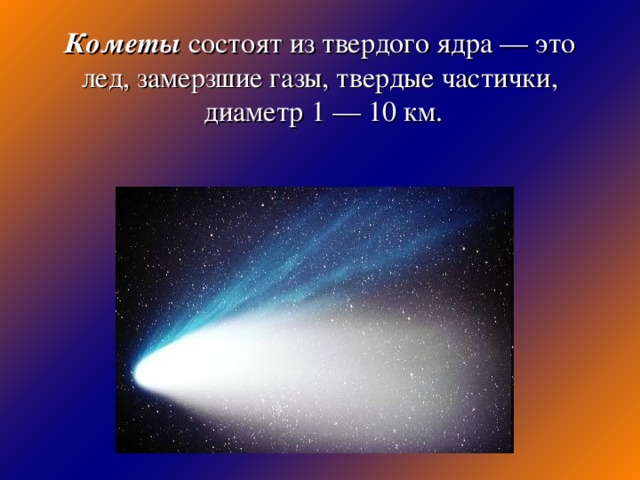
Comets consist of a solid core - ice, frozen gases, solid particles, diameter 1 - 10 km.
As the comet approaches the Sun, the nucleus heats up and substances begin to evaporate.
A gas shell forms around the core, and a long tail. It consists of gases and fine dust and is always directed away from the Sun.
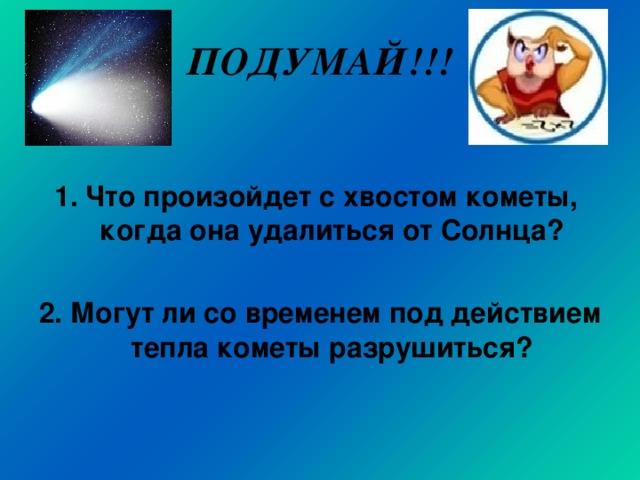
THINK!!!
1. What happens to the comet's tail when it moves away from the Sun?
2. Can comets be destroyed by heat over time?
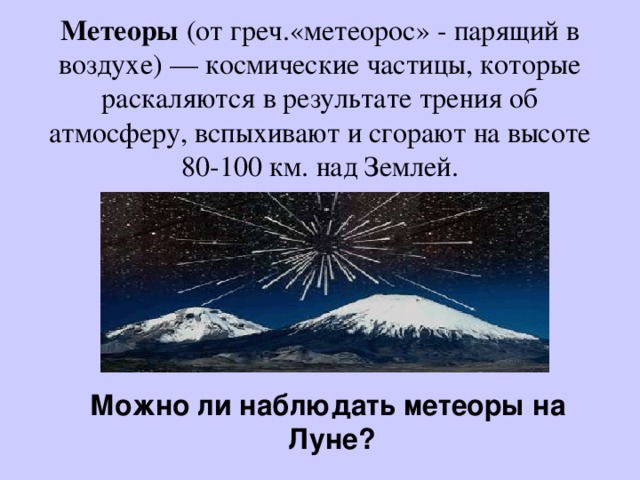
Meteora(from the Greek “meteoros” - floating in the air) - cosmic particles that heat up as a result of friction with the atmosphere, flare up and burn at an altitude of 80-100 km. above the ground.
Is it possible to observe meteors on the Moon?
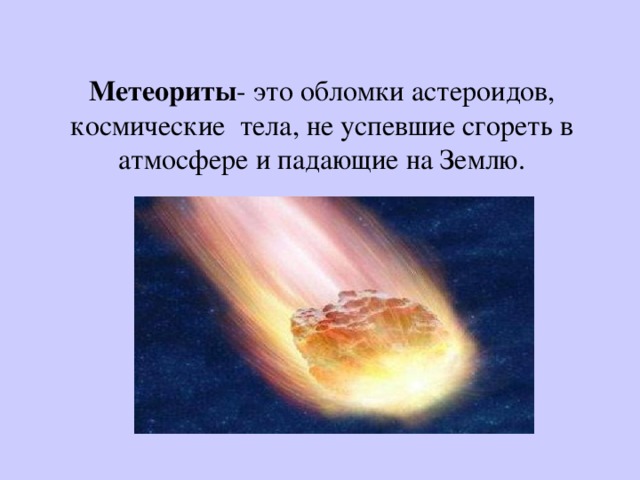
Meteorites- these are fragments of asteroids, cosmic bodies that did not have time to burn up in the atmosphere and fall to Earth.
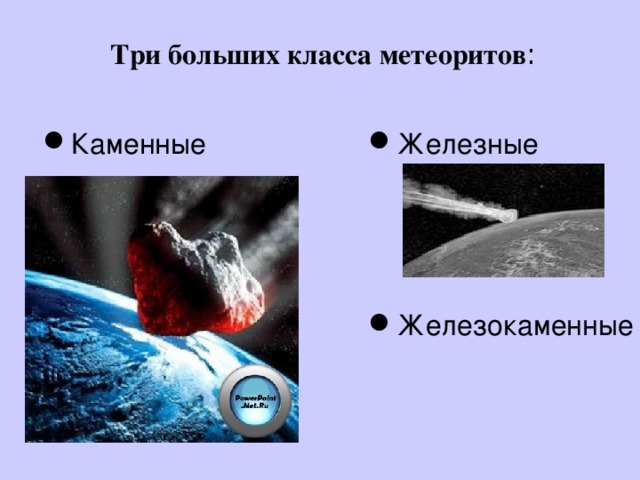
Three large classes of meteorites :
- Stone
- Iron
- Iron-stone
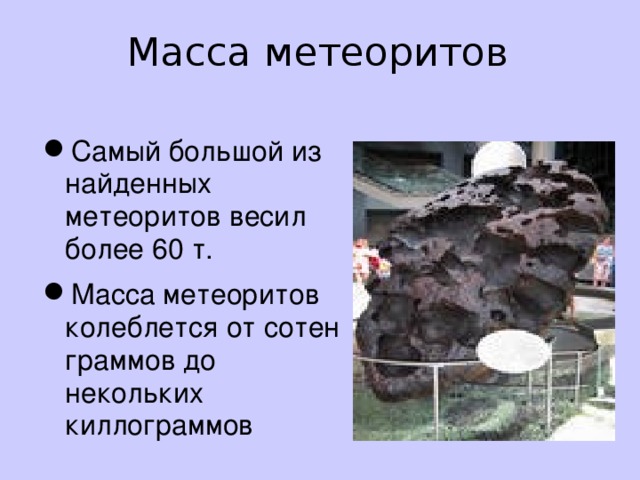
Mass of meteorites
- The largest meteorite found weighed more than 60 tons.
- The mass of meteorites ranges from hundreds of grams to several kilograms
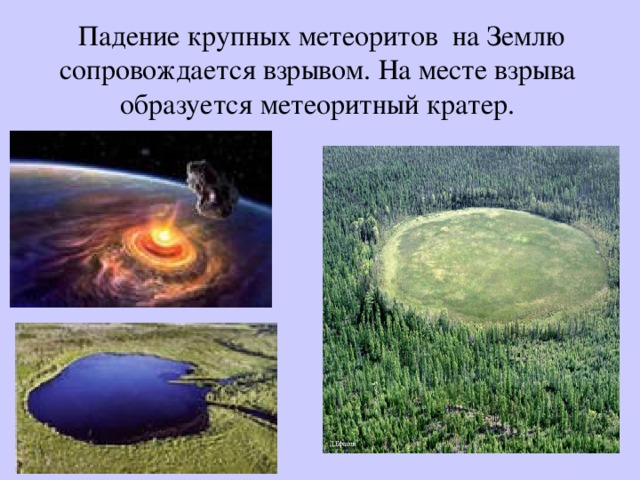
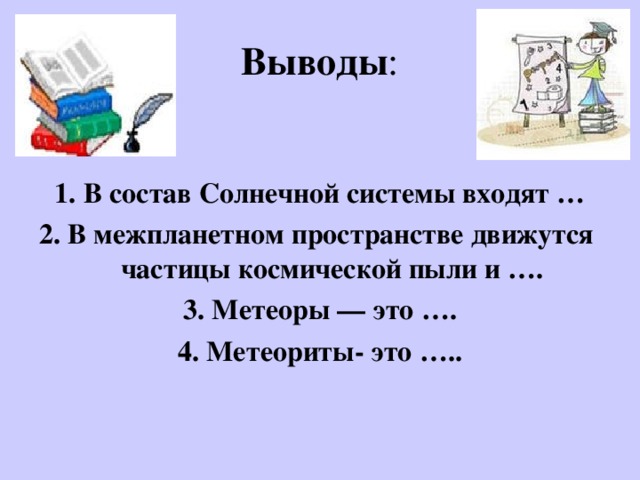
conclusions :
1. The solar system includes...
2. Particles of cosmic dust and… move in interplanetary space.
3. Meteors are….
4. Meteorites are…..
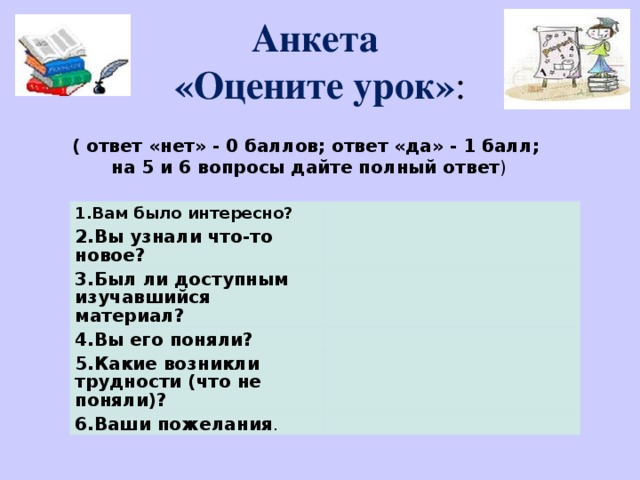
(answer “no” - 0 points; answer “yes” - 1 point;
Give a complete answer to questions 5 and 6)
1.Were you interested?
2.Did you learn something new?
3.Was the material studied available?
4.Did you understand it?
5.What difficulties arose (what was not understood)?
6.Your wishes .
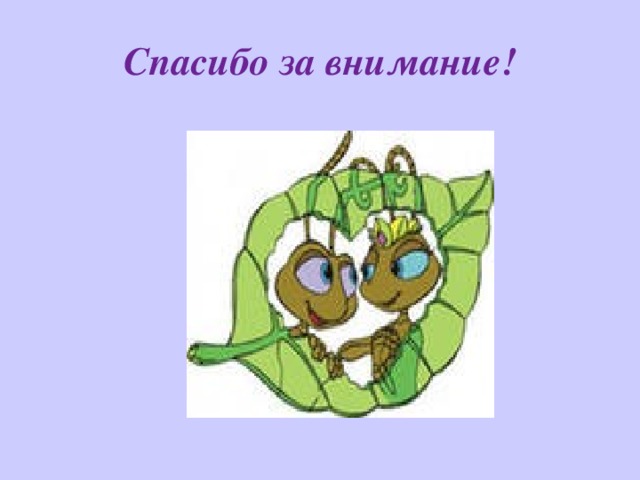
Pugaeva Olga and Chernyshova Dina
Presentation on astronomy on the topic "Asteroids, comets, meteorites and meteors."
Download:
Preview:
To use presentation previews, create a Google account and log in to it: https://accounts.google.com
Slide captions:
Completed the work: Olga Pugaeva and Dina Chernyshova Teacher: V.I. Malysheva MKOU "Secondary school No. 1 village. Warm" Asteroids, comets, meteorites and meteors
Asteroids At the end of the 18th century, German astronomers Titius and Bode independently noticed a pattern in a number of numbers expressing the average distances of planets from the Sun. The fifth member of this series did not correspond to any planet. On January 1, 1801, Italian astronomer Giuseppe Piazzi accidentally discovered a star whose right ascension and declination changed noticeably over the course of 24 hours of observation. Gauss calculated the orbit of this astronomical object and it became clear that a planet had been discovered between Mars and Jupiter. She was named Ceres in honor of the ancient Roman goddess of fertility. In 1802, the German doctor Olbers, who was fond of astronomy, discovered a new planet near Ceres, which was named Pallas. Juno was discovered in 1804, Vesta in 1807. Herschel proposed calling small planets asteroids. Asteroid means "star-shaped" in Greek. In 1804, Olbers expressed the famous hypothesis about the rupture of the hypothetical planet Phaeton between Mars and Jupiter and the formation of asteroids - its fragments. The exact definition of the term "asteroid" is still not established. Until 2006, asteroids were also called minor planets.
Since the end of the 19th century, photography has been used to search for asteroids. With long exposures, images of asteroids appear as dashes due to their rapid movement. Currently, more than 12,000 asteroids are known. At first they were called by the names of deities, then by the names famous people. Until recently, the rule was to call asteroids by female names, making an exception for asteroids with unusual orbits. This rule has now been abandoned. Currently, immediately after discovery, an asteroid is assigned a preliminary designation containing the year of discovery (for example, 1937 DA), and then, if the asteroid's orbit is determined reliably, a permanent number and name. But Olbers’ hypothesis had to be abandoned. Detailed mathematical calculations show that asteroids originated from the fragmentation of not one, but several large bodies.
Currently, hundreds of thousands of asteroids have been discovered in the Solar System. As of September 6, 2011, there were 84,993,238 objects in the databases, 560,021 had precisely defined orbits and were assigned an official number. 15,615 of them at this time had officially approved names. It is estimated that the Solar System may contain from 1.1 to 1.9 million objects larger than 1 km. Most currently known asteroids are concentrated within the asteroid belt, located between the orbits of Mars and Jupiter. Ceres, measuring approximately 975×909 km, was considered the largest asteroid in the Solar System, but since August 24, 2006, it received the status of a dwarf planet.
In 1975, Clark Chapman, David Morrison and Ben Zellner developed a system for classifying asteroids based on chromaticity, albedo and characteristics of the spectrum of reflected sunlight. Initially, this classification defined only three types of asteroids: Class C - carbon, 75% known asteroids. Class S - silicate, 17% of known asteroids. Class M - metal, most others. It should be borne in mind that the number of known asteroids classified as a particular type does not necessarily correspond to reality. Some types are quite difficult to determine, and the type of a given asteroid may change with more careful research. Classification of asteroids
The danger of asteroids At the moment there are no asteroids that could significantly threaten the Earth. The larger and heavier the asteroid, the greater the danger it poses, but in this case it is much easier to detect it. The most dangerous asteroid at the moment is considered to be Apophis, with a diameter of about 300 meters, in a collision with which, in the event of an accurate hit, it can be destroyed Big city, however, such a collision does not pose any threat to humanity as a whole. Asteroids larger than 10 km in diameter can pose a global threat. All asteroids of this size are known to astronomers and are in orbits that cannot lead to a collision with the Earth.
Comets In addition to large planets and asteroids, comets move around the Sun. Comets are the longest objects in the solar system. The word “comet” translated from Greek means “hairy”, “long-haired”. The appearance of most comets is unpredictable. People have been paying attention to them since time immemorial. It is impossible not to notice in the sky a spectacle so rare, and therefore terrifying, more terrible than any eclipse, when a foggy body is visible in the sky, sometimes so bright that it can sparkle through the clouds (1577), eclipsing even the Moon. And from the depths of the uninvited heavenly guest, huge tails burst out... Aristotle in the 4th century BC. e. explained the phenomenon of a comet as follows: light, warm, “dry pneuma” (gases of the Earth) rises to the boundaries of the atmosphere, falls into the sphere of heavenly fire and ignites - this is how “tailed stars” are formed. Aristotle argued that comets cause severe storms and drought. His ideas have been generally accepted for two thousand years. In the Middle Ages, comets were considered harbingers of wars and epidemics. Thus, the Norman invasion of Southern England in 1066 was associated with the appearance of Halley's comet in the sky. The fall of Constantinople in 1456 was also associated with the appearance of a comet in the sky.
Comets are discovered every year. On average, about 20 of them open per year. About 50 comets are available for observation, and over the entire history of mankind, about two thousand appearances of comets have been observed. The orbits of most comets are highly elongated ellipses. In 1702, Edmund Halley proved that the comets of 1531, 1607 and 1682 had the same orbit. It turns out that comets are coming back! The orbital period of Comet Halley around the Sun is 76 years.
Comets arriving from deep space look like nebulous objects with a tail trailing behind them, sometimes reaching a length of several million kilometers. The comet's nucleus is a body of solid particles and ice shrouded in a hazy shell called a coma. A core with a diameter of several kilometers can have around it a coma 80 thousand km in diameter. Streams of sunlight knock gas particles out of the coma and throw them back, pulling them into a long smoky tail that moves behind her in space. The brightness of comets depends very much on their distance from the Sun. Of all the comets, only a very small part comes close enough to the Sun and Earth to be seen with the naked eye. The most prominent ones are sometimes called "great comets."
The structure of a comet As a rule, comets consist of a nucleus and a surrounding light, foggy shell (coma), consisting of gases and dust. U bright comets As we approach the Sun, a “tail” is formed - a weak luminous stripe, which, as a result of light pressure and the action of the solar wind, is most often directed in the direction opposite to our luminary. Tails heavenly wanderers comets vary in length and shape. Some comets have them stretching across the entire sky. For example, the tail of the comet that appeared in 1944 was 20 million km long. And comet C/1680 V1 had a tail stretching for 240 million km. Cases of tail separation from a comet have also been recorded (C/2007 N3 (Lulin)). The tails of comets do not have sharp outlines and are almost transparent - stars are clearly visible through them - since they are formed from extremely rarefied matter (its density is much less than the density of gas released from a lighter). Its composition is varied: gas or tiny dust particles, or a mixture of both. The composition of most dust grains is similar to asteroid material in the solar system, as revealed by the Stardust spacecraft's study of comet 81P/Wilda. In essence, this is “visible nothing”: a person can observe the tails of comets only because the gas and dust glow. In this case, the glow of the gas is associated with its ionization by ultraviolet rays and streams of particles ejected from the solar surface, and dust simply scatters sunlight.
Halley's Comet Astronomers received a comprehensive understanding of them thanks to the successful “visits” in 1986 to Halley’s Comet by the Vega-1 and Vega-2 spacecraft and the European Giotto. Numerous instruments installed on these devices transmitted to Earth images of the comet's nucleus and various information about its shell. It turned out that the nucleus of Comet Halley consists mainly of regular ice(with small inclusions of carbon dioxide and methane ice), as well as dust particles. It is they that form the comet's shell, and as it approaches the Sun, some of them - under the pressure of solar rays and solar wind - turn into the tail. The dimensions of the nucleus of Halley's comet, as scientists correctly calculated, are equal to several kilometers: 14 in length, 7.5 in the transverse direction. The nucleus of Halley's comet has an irregular shape and rotates around an axis, which, as the German astronomer Friedrich Bessel (1784-1846) assumed, is almost perpendicular to the plane of the comet's orbit. The rotation period turned out to be 53 hours - which again agreed well with the calculations of astronomers.
Comets and the Earth The masses of comets are negligible - about a billion times less than the mass of the Earth, and the density of matter from their tails is practically zero. Therefore, “celestial guests” do not affect the planets of the solar system in any way. In May 1910, the Earth, for example, passed through the tail of Halley's Comet, but no changes occurred in the movement of our planet. On the other hand, the collision of a large comet with a planet can cause large-scale effects in the atmosphere and magnetosphere of the planet. A good and fairly well-studied example of such a collision was the collision of debris from comet Shoemaker-Levy 9 with Jupiter in July 1994
Meteors and meteorites Meteorite - body cosmic origin, fallen onto the surface of a large celestial object. Most meteorites found weigh between a few grams and several kilograms. The largest meteorite found is Goba (which was estimated to weigh about 60 tons). It is believed that 5-6 tons of meteorites fall to the Earth per day, or 2 thousand tons per year.
A cosmic body before entering the Earth's atmosphere is called a meteoroid and is classified according to astronomical criteria. For example, it could be cosmic dust, a meteoroid, an asteroid, their fragments, or others meteoroids. Flying through the Earth's atmosphere and leaving a bright luminous trail in it, regardless of whether it flies through the upper layers of the atmosphere and goes back into outer space, burns up in the atmosphere or falls to the Earth, can be called either a meteor or a fireball. Meteors are considered bodies no brighter than 4th magnitude, and fireballs - brighter than 4th magnitude, or bodies whose angular dimensions are distinguishable.
Classification by composition stony chondrites carbonaceous chondrites ordinary chondrites enstatite chondrites achondrites stony-iron pallasites iron mesosiderites
The most common meteorites are stony meteorites (92.8% of falls). The vast majority of stony meteorites (92.3% of stony meteorites, 85.7% of total falls) are chondrites. They are called chondrites because they contain chondrules - spherical or elliptical formations of predominantly silicate composition. Most chondrules are no more than 1 mm in diameter, but some can reach several millimeters. Chondrules are found in a detrital or finely crystalline matrix, and often the matrix differs from chondrules not so much in composition as in crystalline structure. The composition of chondrites almost completely replicates the chemical composition of the Sun, with the exception of light gases such as hydrogen and helium. Therefore, it is believed that chondrites formed directly from the protoplanetary cloud that surrounded and surrounded the Sun, through the condensation of matter and the accretion of dust with intermediate heating.
Achondrites make up 7.3% of stony meteorites. These are fragments of protoplanetary bodies that have undergone melting and differentiation by composition (into metals and silicates). Iron meteorites are composed of an iron-nickel alloy. They account for 5.7% of falls. Iron silicate meteorites have a composition intermediate between stony and iron meteorites. They are relatively rare (1.5% incidence).
Achondrites, iron and iron-silicate meteorites are classified as differentiated meteorites. They presumably consist of matter that has undergone differentiation as part of asteroids or other planetary bodies. Previously, it was believed that all differentiated meteorites were formed as a result of the rupture of one or more large bodies, such as the planet Phaethon. However, an analysis of the composition of various meteorites showed that they were more likely formed from the debris of many large asteroids.
A crater (astrobleme) may form at the site where a large meteorite falls. One of the most famous craters in the world is Arizona. It is assumed that the largest meteorite crater on Earth is Wilkes Earth Crater (diameter about 500 km). Earth and meteorites
Tunguska phenomenon (at the moment it is unclear exactly the meteorite origin of the Tunguska phenomenon. For details, see the article Tunguska meteorite). Fell on June 30, 1908 in the Podkamennaya Tunguska River basin in Siberia. The total energy is estimated at 15.40 megatons of TNT equivalent. Tsarevsky meteorite (meteor shower). Fell on December 6, 1922 near the village of Tsarev Volgograd region. This is a rock meteorite. The total mass of the collected fragments is 1.6 tons over an area of about 15 square meters. km. The weight of the largest fallen fragment was 284 kg. Sikhote-Alin meteorite (total mass of fragments is 30 tons, energy is estimated at 20 kilotons). It was an iron meteorite. Fell in the Ussuri taiga on February 12, 1947. Vitimsky fireball. Fell near the villages of Mama and Vitimsky, Mamsko-Chuysky district Irkutsk region on the night of September 24-25, 2002. The event had a great public resonance, although the total energy of the meteorite explosion is apparently relatively small (200 tons of TNT equivalent, with an initial energy of 2.3 kilotons), the maximum initial mass (before combustion in the atmosphere) is 160 tons, and the final mass of the fragments is about several hundred kilograms.
When large meteorites fall to Earth, large traces are left behind. And when they fall on planets, the craters are even larger: they are clearly visible on them.
Three meteor showers - the Leonids, Andromedids and Draconids - showed very sharp bursts of activity in historical times, and in the case of the Andromedids this was directly related to the destruction of Comet Biela, which in 1845 split into two and was visible as two on its next appearance, in 1852. faint comets separated by a distance of over 1.5 million km. The Draconids were associated with another comet, Giacobini-Zinner. If the orbit of a comet intersects the Earth's orbit, then every year, when the Earth hits the intersection point, meteor showers are observed, which intensify as the Earth and the remnants of the comet approach this point at the same time. If no enhancement is observed, it means that the comet’s matter has more or less evenly scattered throughout its orbit - the comet has completely ceased to exist as a celestial body.
Minor planets - asteroids (Greek asteroideis – star-like) have nothing in common with stars, and are named so only because they are visible through a telescope as point objects. Interesting history of the discovery of small
planets. By the end of the 18th century. the empirical law of planetary distances was known (the so-called Titius-Bode rule), according to which there should have been another unknown planet between Mars and Jupiter
nope. The search for it led the astronomer Piazzi to the discovery in 1801 of the planet Ceres with a diameter of 1003 km. The discovery of three more planets: Palladas - 608 km, Juno - 180 km and Vesta - 538 km - was unexpected. In recent years, asteroids up to 1 km in diameter have been discovered, and their total number reaches several thousand. Since asteroids move, during long photographic exposures they appear as bright white lines against a black background of the starry sky.
Observations have shown that asteroids have an irregular polyhedral shape and move in orbits of various shapes - from circles to highly elongated ellipses; the vast majority of them (98%) are contained between the orbits of Mars and Jupiter (“the main asteroid belt”), but the asteroid Icarus approaches the Sun closer than Mercury, and some move away as far as Saturn. The orbits of most asteroids are concentrated near the ecliptic plane; their circulation periods range from 3.5 to 6 years; they are assumed to rotate around their axes (based on the periodic change in apparent brightness). Based on their material composition, asteroids are divided into stony, carbonaceous and metallic asteroids.
The total mass of all asteroids is estimated at 0.01 Earth masses. Their common attraction does not cause noticeable disturbances in the movement of Mars and other planets.
The orbits of some asteroids intersect with the orbit of the Earth, but the probability of the Earth and an asteroid simultaneously being at the same point and colliding is extremely small. It is believed that 65 million years ago, a celestial body such as an asteroid fell to Earth in the area of the Yucatan Peninsula and its fall caused clouding of the atmosphere and a sharp decrease in the average annual air temperature, which affected the Earth's ecosystem.
Currently, astronomers are concerned about the unusual “invasion” of large celestial bodies in the vicinity of the planets of the solar system. Thus, in May 1996, two asteroids flew at a short distance from the Earth. Many experts suggest that the solar system was caught in a kind of trail of large celestial bodies formed outside our system, and therefore believe that, along with the nuclear threat, the number one danger to our planet has become the danger posed by asteroids. A new important problem has arisen - the creation of space protection of the Earth from asteroids, which should include both ground-based and space-based assets, including those located in deep space. Created
The development of such a system should be carried out on an international basis.
On the other hand, the increase in the number of visible asteroids can be explained by an increase in the volume of astronomical information in last years, after the observations were transferred from the surface of the Earth to near Space.
On the issue of the origin of asteroids, two directly opposing points of view have been expressed. According to one hypothesis, asteroids are fragments big planet(it was called Phaeton), located between Mars and Jupiter at the site of the main asteroid belt and split as a result of a cosmic catastrophe due to the powerful gravitational influence of Jupiter. According to another hypothesis, asteroids are protoplanetary bodies that arose due to the thickening of the dust environment, which could not unite into a planet due to the disturbing action of Jupiter. In both cases, the “culprit” turns out to be Jupiter.
Comets(Greek 1gote1e5- long-haired) - small bodies of the Solar System, moving in highly elongated elliptical or even parabolic orbits. Some comets have perihelia near the Sun and aphelion outside Pluto. The movement of comets in orbits can be either forward or backward. The planes of their orbits lie in different directions from the Sun. The orbital periods of comets vary greatly: from several years to many thousands of years. Tenth part famous comets(about 40) appeared several times; they are called periodic.
Comets have a head and a tail. The head consists of a hard core and coma. The core is an ice conglomerate of frozen gases (water vapor, carbon dioxide, methane, ammonia, etc.) with an admixture of refractory silicates, carbon dioxide and metal particles - iron, manganese, nickel, sodium, magnesium, calcium, etc. It is assumed that the core contains organic molecules. Comet nuclei are small, their diameter ranges from several hundred meters to several (50-70) kilometers. Coma is a gas-dust environment (hydrogen, oxygen, etc.), glowing when approaching the Sun. Near perihelion, from the comet’s nucleus, under the influence of solar heat and corpuscular flows, “evaporation” (sublimation) of frozen gases occurs and a luminous tail of the comet is formed, sometimes more than one. It consists of rarefied gases and small solid particles and is directed in the direction opposite to the Sun. The length of the tails reaches hundreds of millions of kilometers. The Earth has been caught in the tails of comets more than once, for example in 1910. This caused great concern among people then, although there was no danger to the Earth.
falling into cometary tails is not an idea: they are so rarefied that the admixture of poisonous gases contained in cometary tails (methane, cyanogen) in the atmosphere is imperceptible.
Among periodic comets, the most interesting is Halley's comet, named after the English astronomer who discovered it in 1682 and calculated its orbital period (about 76 years). It was in its tail that the Earth found itself in 1910. The last time it appeared in the sky was in April 1986, passing at a distance of 62 million km from the Earth. Careful studies of the comet using spacecraft showed that the icy core of the comet is a monolithic body of irregular shape measuring about 15x7 km, around which a giant hydrogen corona with a diameter of 10 million km was discovered.
Comets are short-lived celestial bodies, since as they approach the Sun they gradually “melt” due to the intense outflow of gases or break up into a swarm of meteors. The meteoric material is subsequently more or less evenly distributed throughout the entire orbit of the parent comet. In this regard, the history of the periodic (about 7 years) comet Bijela, discovered in 1826, is interesting. Twice after its discovery, astronomers observed its appearance, and the third time, in 1846, they managed to record its division into two parts, which, on subsequent returns They were moving further and further away from each other. Then meteoric substance The comet stretched across its entire orbit, during which the Earth crossed an abundant “rain” of meteors.
There is no precise evidence that the Earth has ever collided with a comet nucleus. No more than five comets penetrate into Earth's orbit each year. However, there is a version that the famous Tunguska “meteorite”, which fell in 1908 in the basin of the Pod-Kamennaya Tunguska River, near the village of Vanavara, is a small (about 30 m) fragment of the nucleus of comet Encke, which exploded as a result of thermal heating in the atmosphere, and “ice” and solid impurities “evaporated.” At the same time explosive air wave forest was felled over an area within a radius of 30 km.
In 1994, scientists observed the fall of Comet Shoemaker-Levy onto Jupiter. At the same time, it broke up into dozens of fragments 3-4 km in diameter, which flew one after another at enormous speed - about 70 km/s, exploded in the atmosphere and evaporated. The explosions created a gigantic hot cloud 20 thousand km in size and with a temperature of 30,000 °C. The fall of such a comet to Earth would end in a cosmic catastrophe.
It is believed that the “comet cloud” surrounding the Sun formed along with the Solar System. Therefore, by studying the material of comets, scientists obtain information about the primary material from which planets and satellites were formed. In addition, assumptions have been made about the “participation” of comets in the origin of life on Earth, since radio spectroscopic methods have proven the presence of complex organic compounds (formaldehyde, cyanoacetylene, etc.) in comets and meteorites.
Meteors, usually called “shooting stars”, are tiny (mg) solid particles that fly into the atmosphere at speeds of up to 50-60 km/s, heat up due to friction with the air to several thousand degrees Celsius, ionize gas molecules, causing them to emit light, and evaporate at an altitude of 80-100 km above the earth's surface. Sometimes a large and exceptionally bright fireball appears in the sky, which can break apart and even explode during flight. Such a meteor is called fireball. A similar fireball exploded on September 25, 2002 in the Irkutsk region, between the villages of Mama and Bodaibo. In the sky, both individual meteors appearing randomly in the sky, and groups of meteors in the form of meteor showers, within which particles move parallel to each other, although in perspective it seems that they are scattering from one point in the sky, called radiant. Meteor showers are named by the constellations in which their radiants are located. The Earth crosses the orbit of the Perseids around August 12, the Orionids - October 20, the Leonids - November 18, etc. Meteor showers move along the orbits of those asteroids or comets, as a result of the disintegration of which they are formed. The orbits of meteor showers are carefully studied for the safety of spacecraft and vehicles.
Meteorites(from Greek te1eoga- celestial phenomena) are large meteoroids that fall to Earth. Every year, about two thousand meteorites with a total mass of about 20 tons fall onto the earth's surface. They are fragments of a rounded angular shape, usually covered with a thin black melting crust with numerous cells from the drilling action of air jets. According to their structure, they are of three classes: iron, consisting mainly of nickel iron, stone, which contain predominantly silicate minerals, and iron-stone, consisting of a mixture of these substances. There are two groups of rocks: chondrites (granular meteorites) and
Ironstone 1 ,5%
Iron
achondrites (earthy meteorites). Stony meteorites predominate (Fig. 3). Physico-chemical analysis of meteorites indicates that they consist of chemical elements and their isotopes known on Earth, which confirms the unity of matter in the Universe.
The largest Goba meteorite, measuring 2.75x2.43 m and weighing 59 tons, was found in southwest Africa; it is iron. The Sikhote-Alin meteorite (fell in 1947) split into thousands of pieces in the air and fell to Earth as “iron rain.” The total weight of the collected fragments is about 23 tons; they created 24 impact craters ranging from 8 to 26 m in diameter. The Kaaba meteorite (“Black Stone”) is kept in the Mecca mosque in Saudi Arabia and serves as an object of worship for Muslims. Many meteorites have been discovered in Antarctica, and they are also found in the sediments of the floor of the World Ocean.
Rice. 3.a- relative frequency of meteorite falls of different classes (according to J. Boud); b - mineral composition of a typical chondrite (according to V. E. Khain)
At the dawn of the Earth's existence, when there was still a lot of unused material in the solar system, and the Earth's atmosphere - protection from meteorites - was still very thin, the number of meteorites bombarding the Earth was enormous and its surface resembled the face of the Moon. With time most of craters were destroyed by tectonic and exogenous processes, but many of them were still preserved in the form of ring-shaped geological structures called astroblemes(“star scars”). They are especially visible from space. They reach tens of kilometers in diameter. The study of meteorites allows us to judge the structure and properties of celestial bodies and supplements our information about the internal structure of the Earth.
Moon
The Earth is often, and not without reason, called the double planet Earth-Moon. The Moon (Selene, goddess of the Moon in Greek mythology), our celestial neighbor, was the first to be directly studied.
General information about the moon. Movements of the Moon. The Moon is a natural satellite of the Earth, located at a distance of 384 thousand km (60 radii of the Earth). The average radius of the Moon is 1738 km (almost 4 times less than the Earth's). The Moon's mass is 1/81 that of the Earth, which is significantly greater than similar ratios for other planets in the Solar System (except for the Pluto-Charon pair); therefore, the Earth-Moon system is considered a double planet. It has a common center of gravity - the so-called barycenter, which is located in the body of the Earth at a distance of 0.73 radii from its center (1700 km from the surface of the Ocean).
Both components of the system rotate around this center, and it is the barycenter that moves in orbit around the Sun. The average density of lunar substance is 3.3 g/cm 3 (terrestrial - 5.5 g/cm 3). Volume of the Moon 50 times smaller than Earth. The force of lunar gravity is 6 times weaker than the earth's. The moon rotates around its axis, which is why it is slightly flattened at the poles. The axis of rotation of the Moon makes an angle of 83°22" with the plane of the lunar orbit. The plane of the Moon's orbit does not coincide with the plane of the Earth's orbit and is inclined to it at an angle of 5°9". The intersection of the orbits of the Earth and the Moon is called nodes of the lunar orbit.
The orbit of the Moon is an ellipse, in one of the foci of which the Earth is located, therefore the distance from the Moon to the Earth varies from 356 to 406 thousand km. The orbital period of the Moon and the corresponding
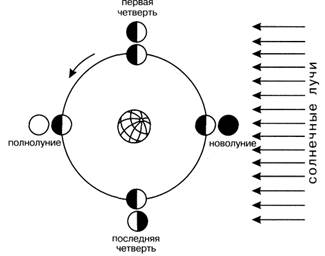
Rice. 4. Moon phases
exactly the same position of the Moon on the celestial sphere is called sidereal(sidereal) month (lat. sidus, sideris(genus) - star). It is 27.3 Earth days. The sidereal month coincides with the period of the daily rotation of the Moon around its axis due to their identical angular speed (= 13.2° per day), established due to the braking effect of the Earth. Due to the synchronicity of these movements, the Moon always faces us with one side. However, we see almost 60% of its surface thanks to libration- to the seeming-
Minor planets - asteroids (Greek asteroedeis- star-like) have nothing in common with stars, and are named so only because they are visible through a telescope as point objects. The history of the discovery of small planets is interesting. By the end of the 18th century. the empirical law of planetary distances was known (the so-called Titius-Bode rule), according to which there should have been another unknown planet between Mars and Jupiter. The search for it led the astronomer Piazzi to the discovery in 1801 of the planet Ceres with a diameter of 1003 km. The discovery of three more planets: Pallas - 608 km, Juno - 180 km and Vesta - 538 km - was unexpected. In recent years, asteroids up to 1 km in diameter have been discovered, and their total number reaches several thousand. Since asteroids move, during long photographic exposures they appear as bright white lines against a black background of the starry sky.
Observations have shown that asteroids have an irregular polyhedral shape and move in orbits of various shapes - from circles to highly elongated ellipses; the vast majority of them (98%) are contained between the orbits of Mars and Jupiter (“the main asteroid belt”), but the asteroid Icarus approaches the Sun closer than Mercury, and some move away as far as Saturn. The orbits of most asteroids are concentrated near the ecliptic plane; their circulation periods range from 3.5 to 6 years; they are assumed to rotate around their axes (based on the periodic change in apparent brightness). Based on their material composition, asteroids are divided into stony, carbonaceous and metallic asteroids.
The total mass of all asteroids is estimated at 0.01 Earth masses. Their common attraction does not cause noticeable disturbances in the movement of Mars and other planets.
The orbits of some asteroids intersect with the orbit of the Earth, but the probability of the Earth and an asteroid simultaneously being at the same point and colliding is extremely small. It is believed that 65 million years ago, a celestial body such as an asteroid fell to Earth in the area of the Yucatan Peninsula and its fall caused clouding of the atmosphere and a sharp decrease in the average annual air temperature, which affected the Earth's ecosystem.
Currently, astronomers are concerned about the unusual “invasion” of large celestial bodies in the vicinity of the planets of the solar system. So, in May 1996, two asteroids flew at a short distance from the Earth. Many experts suggest that the solar system fell into a kind of trail of large celestial bodies formed outside our system, and therefore believe that, along with the nuclear threat, the number one danger for our planet has become the danger posed by asteroids. A new important problem has arisen - the creation of space protection of the Earth from asteroids, which should include both ground-based and space-based assets, including those located in deep space. The creation of such a system should be carried out on an international basis.
On the other hand, the increase in the number of visible asteroids can be explained by the increase in the volume of astronomical information in recent years, after observations were transferred from the Earth's surface to near space.
On the issue of the origin of asteroids, two directly opposing points of view have been expressed. According to one hypothesis, asteroids are fragments of a large planet (it was called Phaethon), located between Mars and Jupiter at the site of the main asteroid belt and split apart as a result of a cosmic catastrophe due to the powerful gravitational influence of Jupiter. According to another hypothesis, asteroids are protoplanetary bodies that arose due to the thickening of the dust environment, which could not unite into a planet due to the disturbing action of Jupiter. In both cases, the “culprit” turns out to be Jupiter.
Comets(Greek cometes- long-haired) - small bodies of the Solar System, moving in highly elongated elliptical or even parabolic orbits. Some comets have perihelia near the Sun and aphelion outside Pluto. The movement of comets in orbits can be either forward or backward. The planes of their orbits lie in different directions from the Sun. The orbital periods of comets vary greatly: from several years to many thousands of years. A tenth of the known comets (about 40) have appeared more than once; they are called periodic.
Comets have a head and a tail. The head consists of a hard core and coma. The core is an ice conglomerate of frozen gases (water vapor, carbon dioxide, methane, ammonia, etc.) with an admixture of refractory silicates, carbon dioxide and metal particles - iron, manganese, nickel, sodium, magnesium, calcium, etc. It is assumed that the core contains organic molecules. Comet nuclei are small, their diameter ranges from several hundred meters to several (50 – 70) kilometers. Coma is a gas-dust environment (hydrogen, oxygen, etc.), glowing when approaching the Sun. Near perihelion, from the comet’s nucleus, under the influence of solar heat and corpuscular flows, “evaporation” (sublimation) of frozen gases occurs and a luminous tail of the comet is formed, sometimes more than one. It consists of rarefied gases and small solid particles and is directed in the direction opposite to the Sun. The length of the tails reaches hundreds of millions of kilometers. The Earth has fallen into the tails of comets more than once, for example in 1910. This then caused great concern among people, although falling into comet tails does not pose any danger to the Earth: they are so rarefied that the admixture of poisonous gases contained in the composition comet tails(methane, cyanogen), imperceptible in the atmosphere.
Among periodic comets, the most interesting is Halley's comet, named after the English astronomer who discovered it in 1682 and calculated its orbital period (about 76 years). It was in its tail that the Earth found itself in 1910. It last appeared in the sky in April 1986, passing at a distance of 62 million km from Earth. Careful studies of the comet using spacecraft showed that the icy core of the comet is a monolithic body of irregular shape measuring about 15x7 km, around which a giant hydrogen corona with a diameter of 10 million km was discovered.
Comets are short-lived celestial bodies, since as they approach the Sun they gradually “melt” due to the intense outflow of gases or break up into a swarm of meteors. The meteoric material is subsequently more or less evenly distributed throughout the entire orbit of the parent comet. In this regard, the history of the periodic (about 7 years) comet Bijela, discovered in 1826, is interesting. Twice after its discovery, astronomers observed its appearance, and the third time, in 1846, they managed to record its division into two parts, which, on subsequent returns They were moving further and further away from each other. Then the meteoric substance of the comet stretched across the entire orbit, during which the Earth crossed an abundant “rain” of meteors.
There is no precise evidence that the Earth has ever collided with a comet nucleus. No more than five comets penetrate into Earth's orbit each year. However, there is a version that the famous Tunguska “meteorite”, which fell in 1908 in the river basin Podkamennaya Tunguska, near the village of Vanavara, is a small (about 30 m) fragment of the nucleus of comet Encke, which, as a result of thermal heating in the atmosphere, exploded, and the “ice” and solid impurities “evaporated”. At the same time, the explosive air wave felled a forest over an area within a radius of 30 km.
In 1994, scientists observed the fall of Comet Shoemaker-Levy onto Jupiter. At the same time, it broke up into dozens of fragments 3–4 km in diameter, which flew one after another at an enormous speed - about 70 km/s, exploded in the atmosphere and evaporated. The explosions created a gigantic hot cloud 20 thousand km in size and with a temperature of 30,000 °C. The fall of such a comet to Earth would end in a cosmic catastrophe.
It is believed that the “comet cloud” surrounding the Sun formed along with the Solar System. Therefore, by studying the material of comets, scientists obtain information about the primary material from which planets and satellites were formed. In addition, assumptions have emerged about the “participation” of comets in the origin of life on Earth, since radio spectroscopic methods have proven the presence of complex organic compounds (formaldehyde, cyanoacetylene, etc.) in comets and meteorites.
Meteors, usually called “shooting stars”, are tiny (mg) solid particles that fly into the atmosphere at speeds of up to 50 - 60 km/s, heat up due to friction with the air to several thousand degrees Celsius, ionize gas molecules, causing them to emit light, and evaporate at an altitude of 80–100 km above the earth’s surface. Sometimes a large and exceptionally bright fireball appears in the sky, which can break apart and even explode during flight. Such a meteor is called fireball. A similar fireball exploded on September 25, 2002 in the Irkutsk region, between the villages of Mama and Bodaibo. In the sky, both individual meteors appearing randomly in the sky, and groups of meteors in the form of meteor showers, within which particles move parallel to each other, although in perspective it seems that they are scattering from one point in the sky, called radiant. Meteor showers are named by the constellations in which their radiants are located. The Earth crosses the orbit of the Perseids around August 12, the Orionids - October 20, the Leonids - November 18, etc. Meteor showers move along the orbits of those asteroids or comets, as a result of the disintegration of which they are formed. The orbits of meteor showers are carefully studied for the safety of spacecraft and vehicles.
Meteorites(from Greek meteora- celestial phenomena) are large meteoroids that fall to Earth. Every year, about two thousand meteorites with a total mass of about 20 tons fall onto the earth's surface. They are fragments of a rounded angular shape, usually covered with a thin black melting crust with numerous cells from the drilling action of air jets. According to their structure, they are of three classes: iron, consisting mainly of nickel iron, stone, which contain predominantly silicate minerals, and iron-stone, consisting of a mixture of these substances. Among the stony ones, there are two groups: chondrites (granular meteorites) and achondrites (earthy meteorites). Stony meteorites predominate (Fig. 3). Physico-chemical analysis of meteorites indicates that they consist of chemical elements and their isotopes known on Earth, which confirms the unity of matter in the Universe.
| A | B |
Rice. 3. a – relative frequency of meteorite falls of different classes (according to J. Boud); b – mineral composition of a typical chondrite (according to V. E. Khain)
The largest Goba meteorite, measuring 2.75x2.43 m and weighing 59 tons, was found in southwest Africa; it is iron. The Sikhote-Alin meteorite (fell in 1947) split into thousands of pieces in the air and fell to Earth as “iron rain.” The total weight of the collected fragments is about 23 tons, they created 24 impact craters ranging from 8 to 26 m in diameter. The Kaaba meteorite (“Black Stone”) is kept in the Mecca mosque in Saudi Arabia and serves as an object of worship for Muslims. Many meteorites have been discovered in Antarctica, and they are also found in the sediments of the floor of the World Ocean.
At the dawn of the Earth's existence, when there was still a lot of unused material in the solar system, and the Earth's atmosphere - protection from meteorites - was still very thin, the number of meteorites bombarding the Earth was enormous and its surface resembled the face of the Moon. Over time, most of the craters were destroyed by tectonic and exogenous processes, but many of them were still preserved in the form of ring-shaped geological structures called astroblemes(“star scars”). They are especially visible from space. They reach tens of kilometers in diameter. The study of meteorites allows us to judge the structure and properties of celestial bodies and supplements our information about the internal structure of the Earth.
Moon
The Earth is often, and not without reason, called the double planet Earth-Moon. The Moon (Selene, goddess of the Moon in Greek mythology), our celestial neighbor, was the first to be directly studied.
General information about the Moon. Movements of the Moon. The Moon is a natural satellite of the Earth, located at a distance of 384 thousand km (60 radii of the Earth). The average radius of the Moon is 1738 km (almost 4 times less than the Earth's). The Moon's mass is 1/81 that of the Earth, which is significantly greater than similar ratios for other planets in the Solar System (except for the Pluto-Charon pair); therefore, the Earth–Moon system is considered a double planet. It has a common center of gravity - the so-called barycenter, which is located in the body of the Earth at a distance of 0.73 radii from its center (1700 km from the surface of the Ocean). Both components of the system rotate around this center, and it is the barycenter that moves in orbit around the Sun. The average density of lunar substance is 3.3 g/cm3 (terrestrial - 5.5 g/cm3). The volume of the Moon is 50 times smaller than the Earth. The force of lunar gravity is 6 times weaker than the earth's. The moon rotates around its axis, which is why it is slightly flattened at the poles. The axis of rotation of the Moon makes an angle of 83°22" with the plane of the lunar orbit. The plane of the Moon's orbit does not coincide with the plane of the Earth's orbit and is inclined to it at an angle of 5°9". The intersection of the orbits of the Earth and the Moon is called nodes of the lunar orbit.
The orbit of the Moon is an ellipse, in one of the foci of which the Earth is located, therefore the distance from the Moon to the Earth varies from 356 to 406 thousand km. The period of orbital revolution of the Moon and, accordingly, the same position of the Moon on the celestial sphere is called sidereal(sidereal) month (lat. sidus, sideris(genus) – star). It is 27.3 Earth days. The sidereal month coincides with the period of the daily rotation of the Moon around its axis due to their identical angular speed (= 13.2° per day), established due to the braking effect of the Earth. Due to the synchronicity of these movements, the Moon always faces us with one side. However, we see almost 60% of its surface thanks to libration– the apparent rocking of the Moon up and down (due to the mismatch of the planes of the lunar and earth’s orbits and the inclination of the Moon’s rotation axis to the orbit) and left and right (due to the fact that the Earth is in one of the foci of the lunar orbit, and the visible hemisphere of the Moon looks at the center of the ellipse ).
When moving around the Earth, the Moon takes different positions relative to the Sun. Associated with this are various Moon phases, i.e., different forms of its visible part. Main four phases: new moon, first quarter, full moon, last quarter. The line on the surface of the Moon separating the illuminated part of the Moon from the unlit part is called terminator(Fig. 4).
During the new moon, the Moon is between the Sun and the Earth and faces the Earth with its unlit side, therefore invisible. In the first quarter, the Moon is visible from the Earth at an angular distance of 90° from the Sun, and the sun's rays illuminate only the right half of the side of the Moon facing the Earth. During a full moon, the Earth is between the Sun and the Moon, the hemisphere of the Moon facing the Earth is brightly illuminated by the Sun, and the Moon is visible as a full disk. During the last quarter, the Moon is again visible from the Earth at an angular distance of 90° from the Sun, and the sun's rays illuminate the left half of the visible side of the Moon. In the intervals between these main phases, the Moon is visible either as a crescent or as an incomplete disk.
The period of complete change of lunar phases, i.e. the period of the Moon returning to its original position relative to the Sun and Earth, is called synodic month. It averages 29.5 mean solar days. During the synodic month on the Moon there is a change of day and night once, the duration of which is 14.7 days. The synodic month is more than two days longer than the sidereal month. This is the result of the fact that the direction of the axial rotation of the Earth and the Moon coincides with the direction of the orbital motion of the Moon. When the Moon completes a full revolution around the Earth in 27.3 days, the Earth will advance approximately 27° in its orbit around the Sun, since its angular orbital speed is about 1° per day. In this case, the Moon will take the same position among the stars, but will not be in the full moon phase, since for this it needs to advance in its orbit another 27° behind the “escaped” Earth. Since the angular velocity of the Moon is approximately 13.2° per day, it covers this distance in about two days and additionally moves another 2° behind the moving Earth. As a result, the synodic month turns out to be more than two days longer than the sidereal month (Fig. 5). Although the Moon moves around the Earth from west to east, its apparent movement in the sky occurs from east to west due to high speed rotation of the Earth compared to the orbital motion of the Moon. Moreover, during the upper climax ( highest point its path in the sky) The moon shows the direction of the meridian (north - south), which can be used for approximate orientation on the ground. And since the upper culmination of the Moon at different phases occurs at different hours of the day: during the first quarter - about 18 o'clock, during the full moon - at midnight, during the last quarter - about 6 o'clock in the morning (local time), this can also be used for rough estimate of time at night.
Physical nature of the Moon. Intensive study of the physical nature of the Moon began in 1959, when the Soviet spacecraft Luna 2 first reached the surface of the Moon, and Luna 3 photographed the far side of the Moon from space. In 1966, Luna-9 made a soft landing on the Moon, establishing that the planet's soil had a solid structure, and not dusty, as some scientists believed. On July 21, 1969, earthlings visited the Moon for the first time - Americans Neil Armstrong and Edwin Aldrin. In 1970 and 1973 Soviet automatic mobile devices - lunar rovers - operated on the Moon for several months. They transmitted more than 20,000 images to Earth and studied the chemical composition and physical and mechanical properties of the lunar soil.
Currently, the relief of the Moon is quite well studied. The dark areas visible to the naked eye, once called “seas,” turned out to be vast waterless lowland plains (the largest is the “Ocean of Storms”), and the light areas—the “continents”—are represented by elevated and mountainous spaces. The maximum height amplitude is more than 10 km. The main planetary structures of the lunar surface are ring craters with a diameter of up to 20–30 km and multi-ring cirques with a diameter of 200 to 1000 km, bordered by mountainous areas. It is assumed that the ring structures have different origins - meteorite, volcanic or combined shock-explosive. A specialist in the relief of planetary bodies, A. A. Lukashov, believes that the structure of the surface of the Moon “demonstrates the subordinate role of endogenous factors compared to cosmogenic factors...”. The meteorite theory is currently the most accepted. Linear formations are also common on the Moon: tectonic faults, elongated mountain ranges and ridges (Caucasus, Alps, Apennines, Carpathians, etc.).
Studies of lunar soil samples delivered to Earth in 1970–1973. American astronauts on the Apollo spacecraft and Soviet spacecraft“Luna” showed that in terms of mineralogical and petrographic composition, the surface clastic rocks of the Moon (the so-called regolith) are similar to terrestrial igneous rocks - basalts, etc. The thickness of the lunar crust is about 65 km. In the crust of the “seas” there is an increased content of heavy elements (iron, titanium, chromium, zirconium, thorium, etc.), in the crust of the “continents” - oxides of silicon, aluminum, sodium, potassium. The lunar surface albedo averages about 7%. The lunar soil, saturated with inert gases, has extremely low thermal conductivity, which is why at a depth of 0.5 m there is a constant temperature of about –50 °C. The Moon's magnetic field is very weak.
The Moon has neither an atmosphere nor a hydrosphere. The temperature on the surface of the Moon varies from +130°C on the illuminated side to –170°C on the shadow side. The reason for temperature contrasts is the lack of air. And since there is no air, there is no wind, no sounds, no clouds, no rain, there is no dawn, no twilight, no rainbow. The sky there is always completely black, on it you can simultaneously see the stars, the Sun and the Earth, which hangs in the sky in the same place.
The main factors in the destruction of rocks on the surface of the Moon and changes in its face are: 1) daily temperature fluctuations; 2) bombardment by meteorites, leading to the melting and sintering of surface rocks and reducing the gravitational displacement of the material; 3) irradiation of surface rocks by solar wind; 4) space vacuum, which must be taken into account during the outpouring of magma onto the surface and its intensive splashing in the early geological epochs(about 2 billion years ago). Now the deep activity of the Moon is weakened, and it is a tectonically lifeless body; moonquakes are rare. The lunar landscape is a rocky desert. With such natural conditions Organic life on the Moon is impossible. There is no generally accepted point of view on the formation of the Moon (“is it a daughter or a “sister” of the Earth?).
Ebbs and flows on Earth. The Moon, being closest to the Earth and largest in mass cosmic body, has the greatest gravitational effect on it, causing tides And low tides in all shells of the Earth: lithosphere, atmosphere, hydrosphere and biosphere. Tidal force– the resultant of the gravitational force of the Moon and the centrifugal force that arises during the rotation of the Earth-Moon system around the barycenter. On Earth, there are simultaneously two high tides at the closest point to the Moon and the most distant one, and two low tides at points located at an angular distance of 90° from the Moon-Earth line (Fig. 6). Since the Moon revolves around the Earth from west to east and travels 13.2° in its orbit during a solar day (24 hours), then lunar day- the period of time between two successive climaxes of the Moon on any meridian of the Earth - turns out to be longer than the solar day by 50 minutes and equal to 24 hours 50 minutes. During the lunar day there are two high tides and two low tides on Earth. The full tidal cycle, i.e. the change in water level in the World Ocean, where the ebb and flow of the tides are most pronounced, between successive high tides (or low tides), is completed in 12 hours 25 minutes, and 6 hours 12 minutes 30 seconds pass between high tide and low tide.
– gravitational force
- centrifugal force
– resultant force
Rice. 6. Tidal forces of the Moon (according to L.K. Davydov and others)
Simultaneously with lunar tides, there are also solar tides with a full period of 24 hours, but they are 2.2 times weaker than lunar tides due to the great distance of the Sun from the Earth. Lunar and solar tides add up to new and full moons (syzygy tides) and are deducted in the first and last quarter (quadrature tides). The former are approximately 40% higher than the latter.
The general planetary significance of tidal waves is that, moving from east to west following the apparent movement of the Moon, they slow down the axial rotation of the Earth and lengthen the day (by 0.0016 With per century). At the same time, not only the figure of the Earth changes due to the slow decrease in polar compression, but also the face of the Earth. Thanks to the tides, all the shells of the Earth continuously pulsate. They cause daily vertical displacements earth's surface up to 50 cm, semi-diurnal fluctuations in surface atmospheric pressure, change the conditions of organic life in the coastal parts of the World Ocean, form the shores, i.e. participate in many natural processes, and also influence economic activity coastal countries.
Rice. 7. Solar (a – total, b – partial) and lunar (total) eclipses
Lunar and solar eclipses. Occur periodically on Earth lunar And solar eclipses. They are observed when the Sun, Earth and Moon are on the same line, that is, when the new moon or full moon occurs near the nodes of the lunar orbit. During the new moon phase, the Moon blocks the disk of the Sun with its opaque body for residents of some regions of the Earth - this happens solar eclipse(full, partial, ring-shaped). During the full moon phase, being on the same line with the Sun and the Earth, the Moon falls into the cone-shaped shadow of the Earth - a lunar eclipse occurs (total or partial), visible on the night hemisphere of the Earth (Fig. 7).
